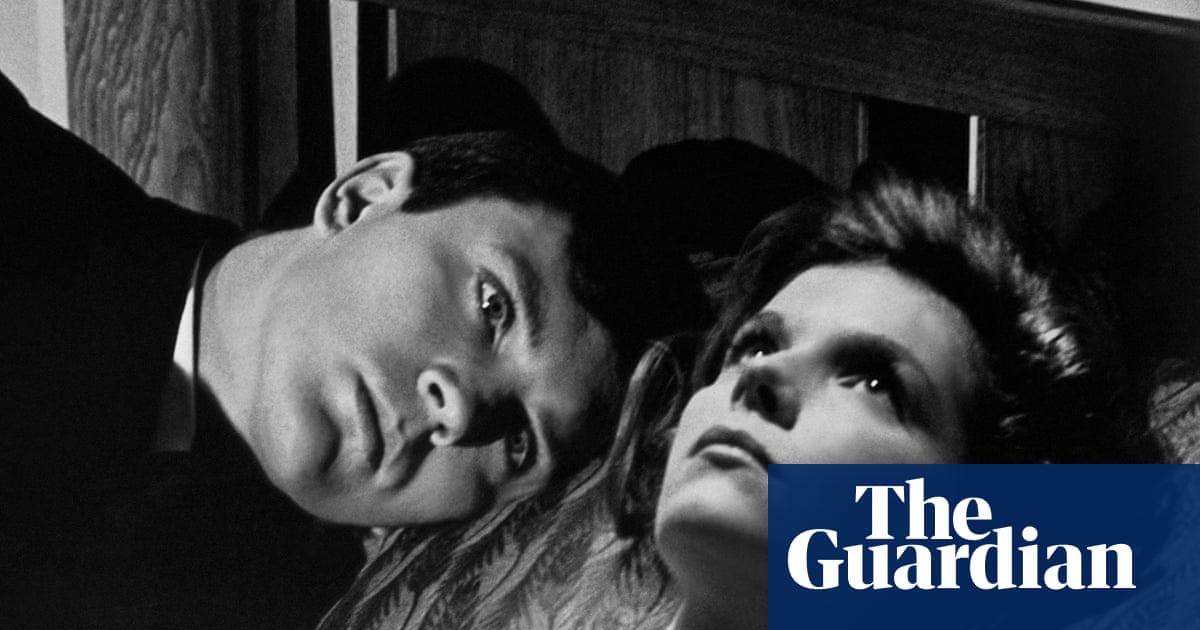You don’t have to live in the American deep south to feel the effects of humidity. At home, just breathing makes the air more humid, let alone cooking or showering.
And when it gets too humid, it’s bad for our health as well as our homes. In fact, the two are connected: humidity lets mould and dust mites flourish – and they, in turn, can trigger asthma and allergies.
Dehumidifiers can make your indoor environment more comfortable by reducing the amount of moisture in the air. Because of this, they’re also a great laundry-drying hack. I use mine to dry clothes fast, and for a fraction of the cost of tumble drying.
Not sure if you need one? You can buy a hygrometer cheaply – the one I used for testing cost less than £10 – to check your home’s relative humidity and make an informed decision. Should you opt to buy one, do your research at reputable sources (like, hint, the Filter). Researching this piece, I was shocked to learn that customers had been duped into buying very basic dehumidifiers for well over the odds.
At a glance
-
Best dehumidifier overall:
Ebac 4650e
-
Best budget dehumidifier:
VonHaus smart dehumidifier with laundry mode
-
Best combined dehumidifier and air purifier:
Devola Platinum Hybrid DVHA20L
-
Best dehumidifier for drying laundry:
Duux Bora Smart
-
Best quiet dehumidifier:
MeacoDry Arete Two
-
Best compact dehumidifier:
Devola DVH12L
Why you should trust me
I’m an award-winning consumer technology journalist with decades of experience testing electrical appliances; I’ve been reviewing gadgets for almost 30 years. I live in a terrace house with a lovely number of children and far too many pets, so there’s lots of laundry: I use a dehumidifier to dry clothes. I’ve also been known to use one for speedy DIY, drying plaster and paint faster.
How I tested
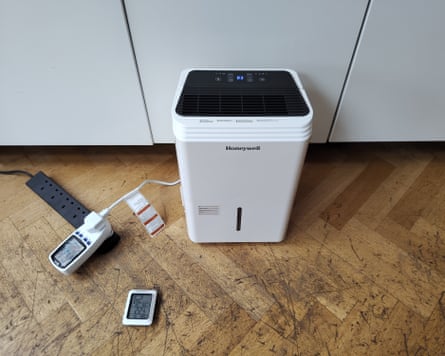
I selected 14 dehumidifiers from leading brands to test, then set them up and used them, each for several days. I used a power meter to measure how much electricity (and therefore money and carbon) they use. Using the Sound Meter app, I measured the noise from 1m away in decibels (dB) on multiple occasions – the figures featured here are all the ones that I measured at home, in consistent conditions, so they often differ from manufacturers’ official figures, which are measured in lab conditions but in inconsistent ways. More subjectively, I paid attention to the quality of the sound – was it annoying, gurgly, hard to ignore, easy to fall asleep to? And I measured each dehumidifier’s size.
To measure the room’s humidity while testing, I used a digital hygrometer held 1m away (though humidity would be roughly the same elsewhere in the room), and a thermometer to check the temperature. Dehumidifiers fill a tank with water they have extracted from the air, so one measure of how good a job they’ve done is to measure how much water is in there – which I did, using a jug.
Because conditions vary from moment to moment and room to room, it was impossible to test each one in precisely the same conditions. As such, I’ve only mentioned the results of these not-so-scientific tests when they stood out.
After testing, any dehumidifiers that weren’t collected by manufacturers were donated to Furnishing Futures, a charity that fully furnishes the empty social housing in which women and children are placed after surviving domestic abuse.
The best dehumidifiers in 2025
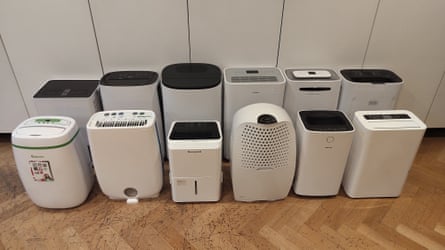
Best dehumidifier overall:
Ebac 4650e
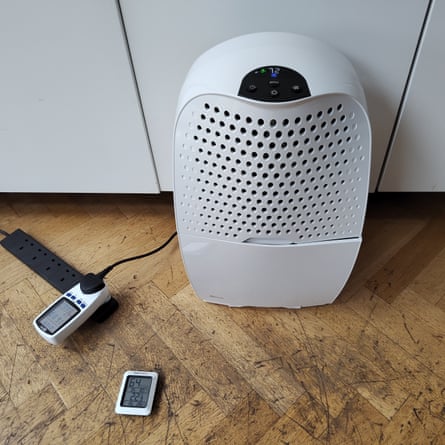
This is the priciest dehumidifier on test, but it’s worth the money. It’s large but luggable, with a single deep handle on the rear that makes it easy to carry and an integrated cable tidy on the back that’s great when you want to store it.
Why we love it
I like the design. For example, a flap at the front opens to reveal a black water tank that’s easy to empty, with water coming out of just one hole (most water tanks are messier).
The small display is colourful, and there’s a good range of modes, including laundry. A smart control feature remembers your home’s humidity levels and kicks in only when the levels start to rise: in a home that doesn’t have major damp problems, this will save a lot of electricity. It can be controlled via an app, and it also comes with an activated carbon filter for removing unwanted smells.
Performance was good, bringing relative humidity down by 4% in a short time, and its capacity and smart controls make it a great all-rounder. You can simply leave it switched on and trust it to manage your home’s humidity levels without wasting electricity. The Ebac’s sound was inoffensive, too: I could definitely sleep with it on. It’s pretty energy efficient and it’s made in north-east England, so its carbon footprint is lower than some other models. It also comes with a four-year warranty if bought directly from the brand.
It’s a shame that … there’s no window to inspect the fill level.
Dimensions: 34 x 27 x 54cm (WDH)
Daily extraction rate: 18l
Tank capacity: 3.5l
Peak power use on test: 180W
Average noise level on top setting: 10dB
Target humidity range: 35-80%
Laundry setting? Yes
Running costs: 5p/hour
Best budget dehumidifier:
VonHaus smart dehumidifier with laundry mode

At the time of writing, a discount code brings this dehumidifier’s price down to less than £150. Even at full price, though, it’s a bargain.
Why we love it
Alongside a laundry mode, there’s a sleep mode, which brought down volume levels from an already quiet 15dB to 10dB by slowing the fan speed, and turns off the screen so the lights won’t disturb you.
Other modes include auto, which turns the machine off when it reaches the target relative humidity, and continuous, which means it won’t turn off until the tank is full. An app lets you control it from your phone or with Google Home or Amazon Alexa. Simple coloured lights on the front give a visual indicator of what mode it’s in.
It’s a great all-rounder for the price. On test, it started cutting humidity levels within minutes, and over a couple of hours, it brought relative humidity down by at least 5%, pulling 450ml of water out of the air. It’s good for drying laundry and tackling damp – the only corner cut, when compared with pricier models, is Hepa air filtration.
If you’re not sure whether or not to invest in a dehumidifier, this is a good buy for the price.
It’s a shame that … it only has a washable dust filter, not Hepa air purification, even though there looks to be enough room for a larger filter.
Dimensions: 31 x 24 x 49cm (WDH)
Daily extraction rate: 20l
Tank capacity: 4.5l
Peak power use on test: 290W
Average noise level on top setting: 15dB
Target humidity range: 30-80%
Laundry setting? Yes
Running costs: 8p/hour
Best combined dehumidifier and air purifier:
Devola Platinum Hybrid DVHA20L

Kill two birds with one stone with this new hybrid model that promises cleaner as well as drier air. It comes with a Hepa filter (for filtering the air), an ioniser (for pulling dust out of the air) and an ultraviolet lamp (for killing germs).
Why we love it
Several models on test come with Hepa filters, but what sets this model apart is that it measures air quality too: simply press a button to get a traffic light measure of PM2.5 particles (green, blue or red light, depending on your air quality). Air pollution is a silent killer, and indoor air quality can be worse than outdoor, so filtering these fine particles is a brilliant idea if you don’t already have an air purifier.
Dehumidifier modes include laundry and night (quieter at 20dB), and the flap on the top is motorised, so it opens automatically and can be set to “swing” to circulate air.
It was great being able to see the air quality improve, as well as the humidity. The Devola is well designed, too: the water tank is accessed from the side and its handle doubles as a visual level indicator. And I found the tank easy to empty without making a mess.
It’s a shame that … it’s not quieter. Hepa filters will need replacing periodically, too (Devola suggests every six months, so budget about £15 a year).
Dimensions: 36 x 27 x 57cm (WDH)
Daily extraction rate: 20l
Tank capacity: 2.9l
Peak power use on test: 330W
Average noise level on top setting: 30dB
Target humidity range: 40-80%
Laundry setting? Yes
Running costs: 9p/hour
Best dehumidifier for drying laundry:
Duux Bora Smart

This is a good-looking dehumidifier, with clean lines. The water drawer at the front has a useful visual indicator, so you can see at a glance how full it is.
It features wifi and app control so that you can set schedules, and an activated carbon filter works to remove odours, gases and smoke.
Why we love it
I loved the four-hour laundry mode: it reduced relative humidity by 5% in the first five minutes, swiftly drying clothes. And you’ll be able to sleep nearby, since the Duux is Quiet Mark certified for its ultra-quiet operation. The night mode turns off the lights, although I had to turn down the fan speed myself – and in my tests it then reached an impressively low average of below 10dB, much quieter than the manufacturer’s claims. It sounds like a fan with a little bit of fridge sound thrown in, but quieter.
I also like that it uses the environmentally friendly R290 refrigerant, which has a low global warming potential (GWP). In fact, its GWP is only triple that of carbon dioxide, while some refrigerants have a GWP that’s hundreds of times that of CO2 (and some refrigerants now banned from sale have GWPs of thousands).
It’s a shame that … it doesn’t offer Hepa air purification at this price.
Dimensions: 32 x 24 x 51cm (WDH)
Daily extraction rate: 20l
Tank capacity: 4l
Peak power use on test: 270W
Average noise level on top setting: 20dB
Target humidity range: 30-80%
Laundry setting? Yes
Running costs: 7p/hour
Best quiet dehumidifier:
MeacoDry Arete Two

You’d expect the successor to the popular Arete One to be impressive, and this doesn’t disappoint. It’s not just a dehumidifier – it also purifies the air, thanks to the included dust and medical-grade H13 Hepa filters.
Why we love it
The Arete Two can be controlled via a smartphone app or voice control via Google Home or Amazon Alexa. Modes include continuous, smart (which aims for a middle-of-the-road 55% humidity) and laundry. The louvre on top opens manually and can be directed at your washing.
Its display is slightly unusual: rather than a number, it shows a sliding scale of humidity levels, giving you a clear visual indication of the current humidity and your target. The interface is intuitive, however, and there aren’t too many buttons.
The five-year warranty is the longest I’ve seen for a dehumidifier. But most of all, I was impressed by the quiet. The average noise was just 5dB, and this went down to 4dB (considerably quieter than the manufacturer’s claimed noise level) in night mode. You can honestly forget that it’s on.
It also has some thoughtful features. For example, if you leave it plugged in but not switched on, it will say “wet” on screen to alert you when it detects a relative humidity of 70% plus.
You can also choose your type of air filtration when you buy refills (£39.99 for a pack of three). Replace the Hepa filter if you have allergies or pets; swap for an activated charcoal filter if you’d prefer to remove cooking smells, smoke and VOCs (chemicals that come off new furniture, paint, carpets and so on).
It’s a shame that … the louvre isn’t motorised, considering the price.
Dimensions: 37 x 27 x 62cm (WDH)
Daily extraction rate: 20l
Tank capacity: 4.8l
Peak power use on test: 230W
Average noise level on top setting: 5dB
Target humidity range: 40-70%
Laundry setting? Yes
Running costs: 6p/hour
Best compact dehumidifier:
Devola DVH12L

When compared with the other smaller (12-litre capacity) models on test, this extracted the most water from the air. It removed 200ml, reducing relative humidity by 5% in a short time. It also looks good.
Why we love it
Performance is impressive for a small dehumidifier. And it’s especially impressive considering it comes with a Hepa filter for air purification, which is bound to slow airflow for dehumidification.
It was pretty quiet and sounded like a fan. I could definitely sleep through its 5dB on low fan mode.
Got enough space for a larger model? For only a little more, you can buy the larger Devola DVHA20L above, which features a built-in PM2.5 air quality monitor, so you can see the impact it’s having on air quality.
It’s a shame that … the rear tank doesn’t have a visual indicator, so you can’t tell how full it is without pulling it out.
Dimensions: 30 x 23 x 47cm (WDH)
Daily extraction rate: 12l
Tank capacity: 2.7l
Peak power use on test: 180W
Average noise level on top setting: 10dB
Target humidity range: 30-80%
Laundry setting? Yes
Running costs: 5p/hour
The best of the rest
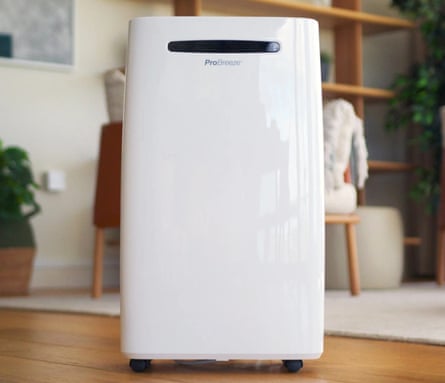
Swan low-energy dehumidifier

Best for: looks
The Swan’s design is as elegant as its feathery namesake. It’s also a contender for best bargain when reduced.
It didn’t make the final cut because … the powerful upwards fan and motorised flap make it great for drying laundry, but there’s no laundry mode, and the minimum target for relative humidity is 40% (many models go down to 30% and laundry mode is invariably 35% with a timer).
You can still dry laundry by choosing 40% and setting a timer, but it seems like an oversight.
after newsletter promotion
Dimensions: 33 x 22 x 57cm (WDH); daily extraction rate: 20l; tank capacity: 4l; peak power use on test: 330W; average noise level on top setting: 30dB; target humidity range: 40-80%; laundry setting? No; running costs: 9p/hour
Meaco DD8L

Best for: a garage or shed
This is a desiccant dehumidifier, rather than a condenser dehumidifier like the others here (see the guide below for more information on the different types). As such, it uses more electricity but can be used in colder spaces, operating as low as 1C: perfect for a garage or shed. This one features an ioniser that helps cut airborne dust, and it’s compact, light and easy to carry. On test, it performed well, cutting relative humidity by 10% but raising the temperature slightly.
It didn’t make the final cut because … it’s good for garages, but since it uses twice as much electricity as condenser dehumidifiers, I wouldn’t use it in the home. It doesn’t display the humidity level, either.
Dimensions: 36 x 20 x 55cm (WDH); daily extraction rate: 8l; tank capacity: 2l; peak power use on test: 690W; average noise level on top setting: 40dB; target humidity range: 40-60%; laundry setting? Yes; running costs: 18p/hour
ProBreeze Dehumidifier with Max Extraction and Laundry Mode

Best for: powerful drying
At the time of writing, the ProBreeze website had a discount code that brought this dehumidifier’s price down by £30, making it a bargain for such a workhorse. In my tests, it extracted moisture powerfully, bringing relative humidity down by more than 10% in a couple of hours. For £10 extra, you can get a version with smart app control.
It didn’t make the final cut because … it uses quite a lot of electricity, even on low power mode. And although it was fairly quiet (15dB on low fan mode), there was an annoying low hum as well as the fan noise.
Dimensions: 32 x 20 x 58cm (WDH); daily extraction rate: 20l; tank capacity: 5.5l; peak power use on test: 360W; average noise level on top setting: 20dB; target humidity range: 30-80%; laundry setting? Yes; running costs: 9p/hour
Devola DV12L

Best for: clever design
I liked the way this affordable dehumidifier looked, and loved the little notch at the top of the rear water tank. It means that, when dry, you can stow the power cable in there, making this an easy machine to store.
A light-up ring on the front indicates relative humidity at a glance: green for good, red for too humid, blue for too dry.
It didn’t make the final cut because … I preferred the newer Devola DVH12L, which also has a Hepa filter for air purification.
Dimensions: 26 x 22 x 47cm (WDH); daily extraction rate: 12l; tank capacity: 2l; peak power use on test: 180W; average noise level on top setting: 25dB; target humidity range: 30-80%; laundry setting? Yes; running costs: 5p/hour
Honeywell TP Fit

Best for: the smallest dehumidifier
This was the smallest on test, so it could be worth considering if you only want to use it occasionally and need to stow it away most of the time. The dust filter is washable, and while there’s no true sleep mode (there’s one that dims the lights, but it doesn’t reduce noise), most of the lights turn off after a minute, and it’s not too loud.
The comfort mode targets a relative humidity based on the temperature, and its front water drawer gives a visual indication. I also like that it uses the environmentally friendly R290 refrigerant, which has a low GWP.
It didn’t make the final cut because … it didn’t reduce humidity as much as some, collecting just 150ml overnight. Also, unusually, I spilled some water when carrying it after testing.
Dimensions: 28 x 24 x 39cm (WDH); daily extraction rate: 12l; tank capacity: 2.5l; peak power use on test: 180W; average noise level on top setting: 20dB; target humidity range: 30-90%; laundry setting? Yes; running costs: 5p/hour
Meaco 12 LE

Best for: compact air purification
This has excellent features, including top-notch air filtration and a three-year warranty from some retailers. Like its big sibling, the MeacoDry Arete Two (above), it purifies the air thanks to an included medical-grade H13 Hepa filter and dust filter. The Hepa filter is optional, and it will need replacing (about every three months) if you want to use it. Budget £40 a year for refills.
It didn’t make the final cut because … you can’t see whether the air purification is working. For only a little more, you can buy the larger Devola DVHA20L, which features a built-in PM2.5 air quality monitor. I also didn’t like the looks, finding the green and white a bit clinical.
Dimensions: 32 x 24 x 49cm (WDH); daily extraction rate: 12l; tank capacity: 2.5l; peak power use on test: 200W; average noise level on top setting: 20dB; target humidity range: 30-80%; laundry setting? Yes; running costs: 5p/hour
Blyss Madden WDH-316DB

Best for: easy carrying
This has a daily extraction rate of 16 litres, which isn’t the weediest but is one of the smaller models on test. It has a simple handle across the full width that’s well balanced. If you find it difficult to carry heavy items up and down stairs, choose a smaller model like this.
I liked the display, with relative humidity and temperature shown inside a cartoon house. And there’s a fan swing function that helps with drying laundry.
It didn’t make the final cut because … there’s no sleep function, although it’s fairly quiet.
Dimensions: 30 x 19 x 47cm (WDH); daily extraction rate: 16l; tank capacity: 2.4l; peak power use on test: 230W; average noise level on top setting: 20dB; target humidity range: 50-70%; laundry setting? Yes; running costs: 6p/hour
Black+Decker BXEH60014GB

Best for: smart controls
I liked the Black+Decker’s design, from the coloured light at the top that indicates humidity (red for high, green for good, blue for low) to the large, white digits on its front that tell you the precise relative humidity.
These quick-glance displays work well when it’s paired with the app, so you can control it from afar. You can even add Google Home and Amazon Alexa voice controls. I could use my phone as a remote control from anywhere in the home to check on progress – rare for a dehumidifier at this price point.
It didn’t make the final cut because … the machine was loud at times (although the sleep setting averaged 17dB).
Dimensions: 34 x 24 x 57cm (WDH); daily extraction rate: 20l; tank capacity: 6.5l; peak power use on test: 395W; average noise level on top setting: 20dB; target humidity range: 30-80%; laundry setting? Yes; running costs: 10p/hour
What you need to know
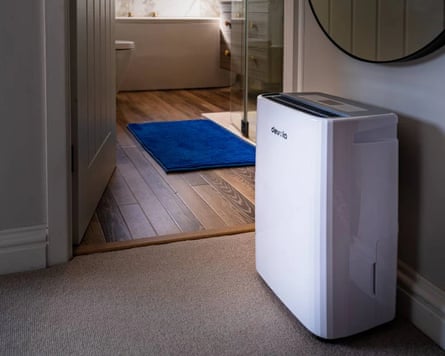
What is relative humidity?
Relative humidity is the percentage of water vapour in the air compared with the maximum that the air can hold.
Warm air can hold more water vapour than cold air. So if the amount of water in the air stays the same but the temperature drops, relative humidity increases.
When relative humidity hits 100%, the air is fully saturated, and water condenses on surfaces, like how dew condenses on cool morning grass.
What humidity should I aim for?
All the dehumidifiers tested here measure the relative humidity (a percentage) and let you set a target.
If the air is too humid, it feels muggy, and it’s hard for sweat to cool you on a hot day. If the air is too dry, it can lead to problems such as dry eyes and throats.
For your health and your home, the ideal relative humidity is 40-60% in summer and 30-50% in winter.
Do I need a dehumidifier?
You might benefit from a dehumidifier if you have damp and mould problems. Humidity helps mould and dust mites flourish – and they, in turn, can trigger asthma and allergies.
Another benefit is to dry laundry fast. Use a dehumidifier to pull moisture out of the air, then clothes in the room dry much faster and without causing damp problems such as condensation on windows or walls.
Dehumidifiers are also good for specific uses, such as drying paint or plaster faster, or helping a room dry out after flooding.
If in doubt, use a cheap hygrometer to check your home’s relative humidity and make an informed decision.
What are the different types of dehumidifier?
Most of the dehumidifiers tested here are compressor dehumidifiers, so they work a bit like a fridge, compressing and then expanding a refrigerant to cool a metal coil. Water from the air then condenses on the coil and drains off into a water tank. These are usually the best style of dehumidifier for the home.
Don’t throw away the plastic tube if you find one in the box. Some models come with a drain hose – so you can constantly dry rather than stopping when the tank is full. Other models let you add a hose if you need it (but most people don’t use them, which is why they’re not always included).
I tested one desiccant dehumidifier. These excel in cold environments, such as garages, cellars and outbuildings. This is because they work by using moisture-absorbing materials that don’t rely on temperature to remove humidity. However, they use more electricity to do so. They don’t require refills (none of the units featured here need refills for dehumidification – the only ongoing cost apart from electricity is that some have Hepa air filters that need replacing every three to six months).
Peltier dehumidifiers are small and quiet, but they’re not very effective and they use more energy, so we haven’t featured any in this roundup.
What size dehumidifier do I need?
The larger (20l a day) models tested here are good for larger homes and open-plan spaces. You can put them somewhere central to tackle humidity in the whole home.
The smaller (12l a day) models are very popular and better for smaller homes or single tasks, such as drying laundry. However, if you have persistent damp problems, then it could be worth sizing up.
You can add a hose to most dehumidifiers if you want to keep them in constant use without having to empty the tank.
How much does a dehumidifier cost to run?
I measured each dehumidifier’s power use on the top setting, in watts (W). Electricity costs are in kilowatt hours (kWh). For example, if you’re running a 200W dehumidifier for four hours, it would use 800Wh or 0.8kWh.
The energy price cap for 1 October to 31 December 2025 is 26.35p a kWh. Multiply this by the last figure and you’ll discover it costs 21p to run the dehumidifier for four hours.
This compares favourably with a tumble dryer. One load in a traditional model uses about 4.5kWh (£1.19), although an energy-saving heat pump model uses half that. Either way, it’s much cheaper to run a dehumidifier than either type of tumble dryer.
What’s a laundry mode?
Many dehumidifiers have a laundry mode that aims for a low relative humidity of 35%, with a timer that turns off automatically, typically after six hours.
To dry laundry effectively, hang it in a room, turn on the dehumidifier and close the doors. That way, it’s drying the air (and speeding the laundry drying) without having to dry moister air that comes in from the outside world.
For more, read the Filter’s guides:
The best heated airers, tested
The best electric heaters
The best electric blankets to keep you toasty for less
Caramel Quin is a journalist specialising in consumer technology. She prides herself on real-world testing and plain language. Her pet hates are jargon, pointless products and overcomplicated instruction manuals. Caramel is an engineering graduate who has won awards for communicating hi-tech subjects to normal people. When she’s not testing gadgets, she’s feeding pets (16 beasts at the time of writing) or pottering at the allotment

 4 hours ago
8
4 hours ago
8


















